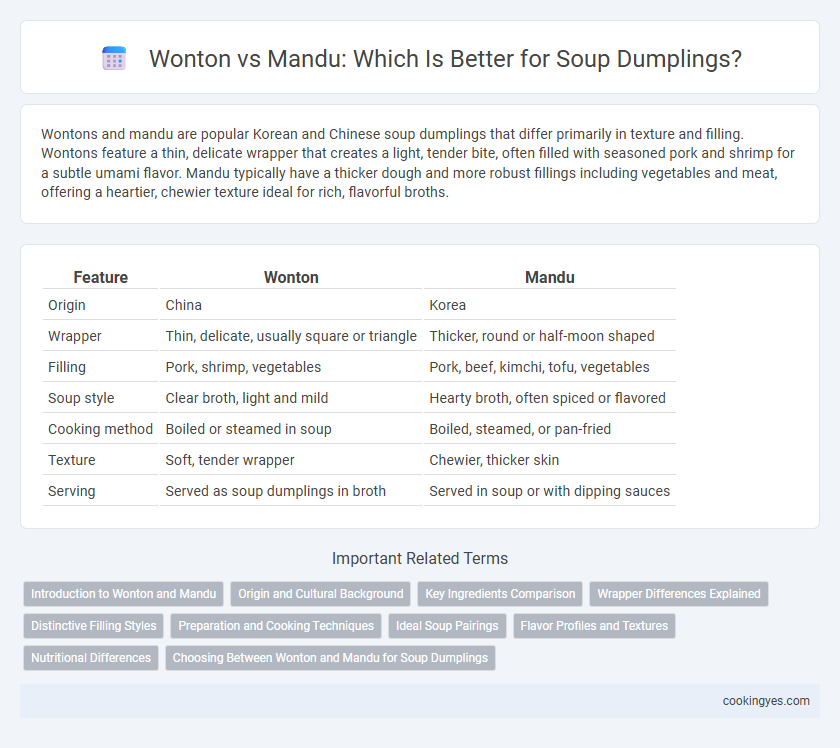Wontons and mandu are popular Korean and Chinese soup dumplings that differ primarily in texture and filling. Wontons feature a thin, delicate wrapper that creates a light, tender bite, often filled with seasoned pork and shrimp for a subtle umami flavor. Mandu typically have a thicker dough and more robust fillings including vegetables and meat, offering a heartier, chewier texture ideal for rich, flavorful broths.
Table of Comparison
| Feature | Wonton | Mandu |
|---|---|---|
| Origin | China | Korea |
| Wrapper | Thin, delicate, usually square or triangle | Thicker, round or half-moon shaped |
| Filling | Pork, shrimp, vegetables | Pork, beef, kimchi, tofu, vegetables |
| Soup style | Clear broth, light and mild | Hearty broth, often spiced or flavored |
| Cooking method | Boiled or steamed in soup | Boiled, steamed, or pan-fried |
| Texture | Soft, tender wrapper | Chewier, thicker skin |
| Serving | Served as soup dumplings in broth | Served in soup or with dipping sauces |
Introduction to Wonton and Mandu
Wontons and Mandu are popular types of Asian dumplings often used in soups, each with distinct regional origins and preparation styles. Wontons, originating from Chinese cuisine, feature thin, smooth wrappers typically filled with a mix of ground pork, shrimp, and seasonings, folded into intricate shapes. Mandu, a staple in Korean cuisine, usually has thicker wrappers and can be filled with a variety of ingredients such as pork, kimchi, tofu, or vegetables, offering a heartier texture in soups.
Origin and Cultural Background
Wontons originate from China's Cantonese and Sichuan regions, traditionally filled with minced pork and shrimp, showcasing subtle seasoning that complements clear broths in Chinese soups. Mandu, rooted in Korean cuisine and influenced by Chinese dumplings, often incorporates ingredients like kimchi and garlic, reflecting Korea's distinct spicy and robust flavor profiles in hearty soups. Both dumplings symbolize cultural heritage, with wontons emphasizing delicate textures and mandu highlighting bold, savory fillings in their respective soup traditions.
Key Ingredients Comparison
Wonton soup dumplings typically contain a mixture of ground pork, shrimp, ginger, garlic, soy sauce, and sesame oil, creating a delicate, savory filling with a smooth texture. Mandu, a Korean variant, often incorporates ground pork or beef, tofu, kimchi, garlic, green onions, and Korean spices, lending a more robust and spicy flavor profile. Both use a thin dough wrapper, but the distinct ingredient combinations define their unique tastes and textures in soup dumplings.
Wrapper Differences Explained
Wonton wrappers are typically thinner and more translucent, made from wheat flour, water, and egg, providing a delicate texture that cooks quickly in soup. Mandu wrappers, often thicker and chewier, use a similar flour base but without eggs, resulting in a sturdier wrapper that holds up well in boiling broths. These wrapper differences affect the dumpling's mouthfeel and cooking time, with wonton wrappers delivering a softer bite and mandu wrappers offering a heartier texture in soup dishes.
Distinctive Filling Styles
Wonton soup dumplings feature a delicate filling typically made with a finely minced mixture of pork, shrimp, and seasonings, creating a smooth texture that complements the thin wheat-based wrapper. Mandu, often found in Korean cuisine, incorporates a heartier filling combining ground beef or pork with garlic, ginger, tofu, and vegetables like kimchi or napa cabbage, offering a robust and textured bite. These distinctive filling styles influence the dumpling's flavor profile and mouthfeel, making wonton lighter and mandu more savory and complex.
Preparation and Cooking Techniques
Wonton soup dumplings are made with a thin, tender dough filled primarily with pork and shrimp, folded into delicate shapes and typically boiled or steamed to preserve their light texture. Mandu, a Korean variant, uses a slightly thicker dough and a more diverse filling, including vegetables and tofu, often pan-fried or steamed to add a chewy bite and enhanced flavor. The preparation of wonton emphasizes a smooth, translucent wrapper, while mandu preparation focuses on creating a heartier dumpling with a robust cooking technique that includes steaming, boiling, or pan-frying for varied textures.
Ideal Soup Pairings
Wonton soup pairs perfectly with light, clear broths such as chicken or seafood stock, enhancing its delicate wrapper and subtle fillings like shrimp or pork. Mandu soup benefits from richer, heartier broths including beef or spicy kimchi-based soups that complement its thicker dough and fermented flavors. Both dumplings thrive in soups that balance texture and taste, optimizing the savory, umami-rich experience of each variety.
Flavor Profiles and Textures
Wonton soup dumplings feature a thin, delicate wrapper that becomes silky and tender when boiled, offering a light, savory broth infused with subtle ginger and garlic notes. Mandu, often thicker and chewier, delivers a heartier texture with robust fillings typically seasoned with soy sauce, sesame oil, and garlic, creating a bolder, more savory flavor experience. Both dumplings balance umami-rich meats or vegetables, but wontons emphasize a smoother mouthfeel, while mandu provides a satisfying chew and pronounced seasoning in soup preparations.
Nutritional Differences
Wontons typically contain pork, shrimp, or a combination, offering a moderate protein content with lower fat levels compared to mandu, which often includes beef or a mixture of meats, resulting in higher calorie and fat values. Mandu's thicker dough wrapper contributes more carbohydrates and calories, while wontons remain lighter due to thinner wrappers. Wontons generally provide fewer calories and saturated fats, making them a favorable option for those seeking a lower-fat soup dumpling.
Choosing Between Wonton and Mandu for Soup Dumplings
Choosing between wonton and mandu for soup dumplings depends on texture and flavor preferences; wontons feature a thinner, more delicate wrapper that becomes silky when boiled, complementing lighter broths. Mandu usually has a thicker, chewier dough that holds up well in hearty, spiced soups, offering a more robust bite. Both varieties accommodate diverse fillings, but wonton's subtle neutrality contrasts with mandu's richer taste profiles, influencing the overall soup experience.
Wonton vs Mandu for soup dumplings Infographic

 cookingyes.com
cookingyes.com